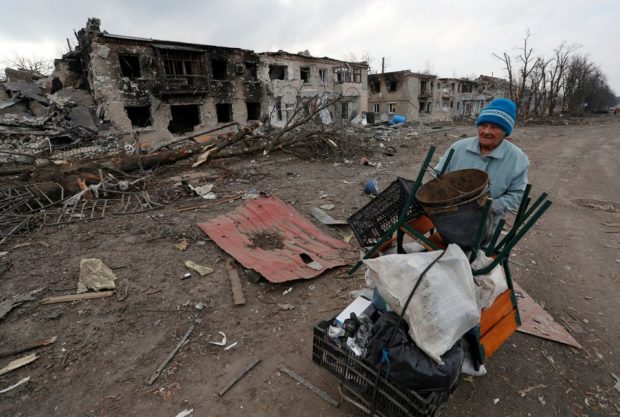
A woman pushes a trolley with her belongings along a street damaged during Ukraine-Russia conflict in the separatist-controlled town of Volnovakha in the Donetsk region, Ukraine March 15, 2022. REUTERS
GENEVA — Nine out of 10 Ukrainians could face poverty and extreme economic vulnerability if the war drags on over the next year, wiping out two decades of economic gains, the UN Development Program (UNDP) said on Wednesday.
Achim Steiner, UNDP Administrator, said that his agency was working with the Kyiv government to avoid a worst case scenario of the economy collapsing. It aimed to provide cash transfers to families to buy food to survive and keep them from fleeing while propping up basic services.
“If the conflict is a protracted one, if it were to continue, we are going to see poverty rates escalate very significantly,” Steiner told Reuters.
“Clearly the extreme end of the scenario is an implosion of the economy as a whole. And that could ultimately lead to up to 90% of people either being below the poverty line or being at high risk of (poverty),” he said in a video interview from New York.
The poverty line is generally defined as purchasing power of $5.50 to $13 per person per day, he added in a video interview from New York. Before Russia launched its invasion on Feb. 24, an estimated 2% of Ukrainians lived below the $5.50 line, he said.
Ukraine’s top government economic adviser Oleg Ustenko said last Thursday that invading Russian forces have so far destroyed at least $100 billion worth of infrastructure and that 50% of Ukrainian businesses had shut down completely.
“We estimate that up to 18 years of development gains of Ukraine could be simply be wiped out in a matter of 12 to 18 months,” Steiner said.
Cash transfers
UNDP is looking at “tried and tested” programmes that it has used in other conflict situations, he said.
“Cash transfers programmes particularly in a country such as Ukraine where the financial system and architecture is still functional, where ATMs are available, a critical way in which to reach people quickly is with cash transfers or a temporary basic income,” he said.
The logistical challenges were significant but “not insurmountable”, he said.
“Clearly some of the recent announcements by World Bank and International Monetary Fund in terms of credit lines and funding that is being made available will obviously assist Ukrainian authorities to be able to deploy such a programme,” he said.
The UNDP report said that an emergency cash transfer operation, costing about $250 million per month, would cover partial income losses for 2.6 million people expected to fall into poverty. A more ambitious temporary basic income programme to provide $5.50 per day per person would cost $430 million a month.
Ukraine’s economy is expected to contract by 10% in 2022 as a result of Russia’s invasion, but the outlook could worsen sharply if the conflict lasts longer, the IMF said in a staff report released on Monday.
The World Bank on Monday approved nearly $200 million in additional and reprogrammed financing to bolster Ukraine’s support of vulnerable people. The funding comes on top of $723 million approved last week and is part of a $3 billion package of support that the World Bank is racing to get to Ukraine and its people in coming weeks.
Steiner emphasized Ukraine’s importance to the economies of other nations, especially a group of African nations who he said get a third of their wheat supplies from Ukraine and Russia.
“We are also trying to stabilise an economy that is for 45 African nations, least developed countries, the breadbasket for them,” Steiner said.
RELATED STORIES
Russia says quitting Council of Europe
Over 3 million have fled fighting in Ukraine
Nato fears Russian chemical attack in Ukraine
Mayor invites Pope Francis to Kyiv to ‘show compassion’